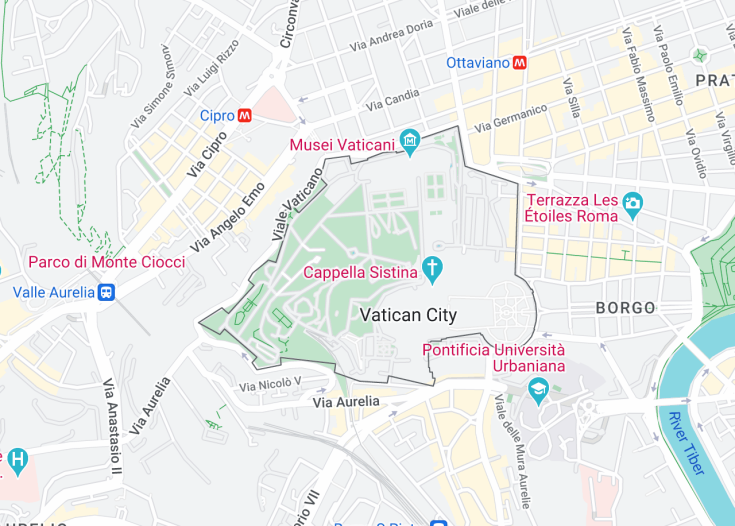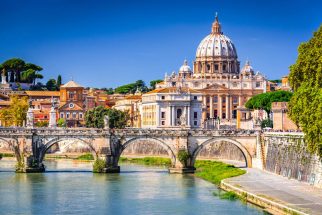Enveloped within the heart of Rome, the Holy See is the spiritual and administrative center of the Roman Catholic Church. This city-state, encompassing Vatican City, stands as a bastion of religious history and art. Within its walls lie the magnificent St. Peter’s Basilica, the Sistine Chapel adorned with Michelangelo’s celestial frescoes, and the Vatican Museums holding countless artistic masterpieces. The Holy See, beyond its religious significance, is a treasure trove of cultural and historical wonders, offering visitors a journey through epochs of faith and unparalleled artistic achievement.
Reserve your Vatican Museums tickets online in advance to avoid the often extensive queues.
For a more intimate experience, consider joining a guided evening tour of the Vatican Museums.
Top destinations in Holy See
Holy See: the spiritual capital of the world
| Capital | Vatican City |
| Time in Holy See | GMT+1 |
| Language spoken | Latin (official), Italian |
| Population | 801 (Source: Vatican Yearbook, 2021) |
| Religion | Roman Catholicism (100%) |
| Currency | Euro (€, EUR) |
| Airports | No civil airports. Closest major airport: Leonardo da Vinci–Fiumicino Airport in Rome, Italy. |
The Holy See, an entity unique in the geopolitical landscape, serves as the epicenter of the Roman Catholic Church and is the smallest sovereign entity in the world by both area and population. Its significance emanates not only from its spiritual dimension but also its historical and diplomatic roles. Enshrined within the heart of Rome, the Holy See’s history is a tapestry of faith, art, culture, and international relations. While not synonymous with Vatican City, the Holy See predates it, tracing its origins to early Christianity. Over centuries, it has witnessed the rise and fall of empires, playing a pivotal role in shaping Western culture and thought. It has acted as a mediator in international disputes, championed causes for global peace, and consistently been a voice on issues of moral and ethical import.
Where is Holy See located?
The Holy See is situated within Vatican City, an independent city-state enclaved within Rome, Italy, making it the spiritual and administrative center of the Roman Catholic Church.
What is Holy See famous for?
The Holy See is renowned as the spiritual leadership of the Roman Catholic Church, its diplomatic endeavors, and its vast collection of art, including the Sistine Chapel ceiling painted by Michelangelo.
History
Early Christianity: 1st – 4th Century AD
The origins of the Holy See trace back to the early Christian community established in Rome by the Apostles Peter and Paul. The Apostle Peter, recognized as the first bishop of Rome, became the foundation for the papal line of successors. With the Edict of Milan in 313 AD, Emperor Constantine officially recognized Christianity, paving the way for the Church’s growth in the Western Roman Empire.
Papal Establishment: 4th – 9th Century AD
Following the fall of the Western Roman Empire in the late 5th century, the papacy began to establish its temporal authority over the city of Rome and the surrounding regions. By the 8th century, under the protection of the Frankish rulers, the Papal States were formed, marking the beginning of the temporal power of the popes.
Medieval Era: 9th – 14th Century AD
Throughout the medieval period, the Holy See played a pivotal role in European politics and religious matters. Key events like the East-West Schism in 1054, the launch of the Crusades, and various church reforms showcased the papacy’s influence. The Avignon Papacy (1309-1377) marked a temporary relocation of the popes to France, before returning to Rome.
Renaissance and Reformation: 14th – 17th Century AD
The Renaissance period witnessed the papacy sponsoring art, architecture, and science, with Rome becoming a center of culture. The Holy See commissioned masterpieces from artists like Michelangelo and Raphael. However, the Church faced internal corruption, leading to the Protestant Reformation in the 16th century. In response, the Catholic Church initiated the Counter-Reformation, solidifying Catholic doctrine and practices at the Council of Trent.
Decline of Temporal Power: 18th – 19th Century AD
The Enlightenment and rise of nationalism in Europe posed challenges for the Holy See’s temporal powers. The French Revolution and Napoleonic era led to the temporary dissolution of the Papal States. Although restored after Napoleon’s fall, they were finally absorbed into the newly unified Kingdom of Italy in 1870, confining the pope to Vatican City.
Establishment of Vatican City: 20th Century AD
In 1929, the Lateran Treaty between the Holy See and the Kingdom of Italy recognized Vatican City as an independent city-state, ensuring the pope’s sovereignty. The 20th century witnessed various social changes, to which the papacy responded with landmark encyclicals and the pivotal Second Vatican Council (1962-1965), modernizing many Church practices and stances.
Contemporary Era: 21st Century AD
The Holy See continues to play a vital role in global affairs, advocating for peace, justice, and moral values. Popes like John Paul II, Benedict XVI, and Francis have addressed contemporary challenges, from interfaith dialogue to environmental concerns. Vatican City remains a focal point of Christian pilgrimage and a testament to the enduring legacy of the Catholic Church.
Visit Holy See
What to see and do in Holy See
When visiting Holy See, there are several must-see attractions and activities to explore:
- St. Peter’s Basilica: Visit the largest Christian church in the world, known for its stunning architecture and religious significance.
- Vatican Museums: Explore the extensive collection of art and historical artifacts, including masterpieces such as the Sistine Chapel.
- Sistine Chapel: Admire Michelangelo’s iconic ceiling frescoes, including the famous depiction of the Creation of Adam.
- St. Peter’s Square: Experience the grandeur of the square, where the Pope delivers his public addresses.
- Vatican Gardens: Take a peaceful stroll through the beautifully landscaped gardens, offering a serene escape from the bustling city.
Events in Holy See
Holy See is home to various events and celebrations throughout the year. One of the most significant events is the Easter Vigil and Easter Sunday Mass celebrated by the Pope at St. Peter’s Basilica. This is a time when many pilgrims and visitors gather in Holy See to experience the religious traditions and ceremonies.
Best time to visit Holy See
The best time to visit Holy See is during the spring and autumn months, specifically from April to June and September to October. During these periods, the weather is mild, and the city is less crowded compared to the peak summer months. Additionally, attending the Easter Vigil and Easter Sunday Mass can be a unique and memorable experience for those interested in religious traditions.
Is Holy See worth visiting?
Yes, Holy See is definitely worth visiting for those interested in religious and art history. The city is home to significant religious sites, including St. Peter’s Basilica and the Vatican Museums, which house some of the world’s most renowned works of art. The spiritual and cultural importance of the Holy See cannot be understated, and witnessing the grandeur of its churches and experiencing the rich traditions of the Catholic Church can be a profound experience. However, it is important to note that Holy See may not appeal to everyone, especially those who are not interested in religious or historical attractions. In such cases, there are plenty of other destinations to explore in Italy and beyond.











